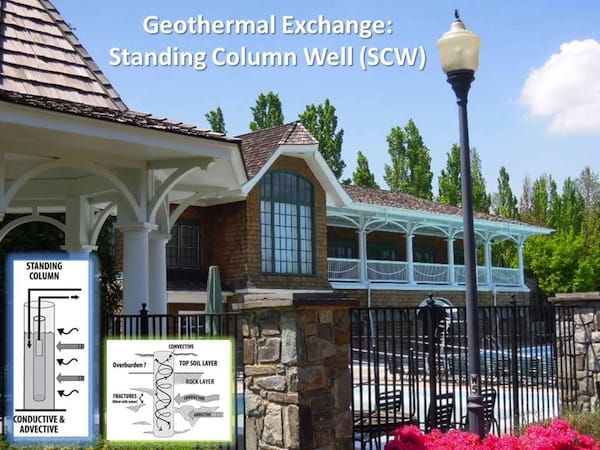
By Jay Egg
There are 3 main types of geothermal exchange wells (drilled). They are:
The first two have been referred to in previous articles. The Standing Column Well (SCW) is typically used in a specific geology. Primarily an SCW is used in areas where water is found in smaller quantities of fairly competent rock fractures.
A standing-column well (SCW) is a collaboration of the best characteristics of Class-V Thermal Exchange (open-loop) and a closed-loop earth-coupled geothermal heat pump (GHP) system. Those two methods represent the opposing extremes of earth-coupling methods employed by GHP system installations.
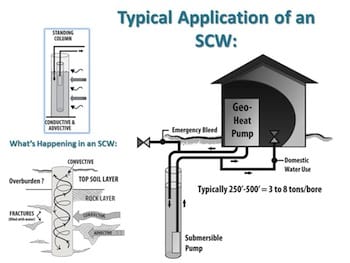 An open-well system has the advantages of the lowest first cost and the highest efficiency, but a large water yield from a surface or groundwater well is often not possible. Even if it is possible, there may not be a reasonable way to get the water back into the environment. As installations become larger, the use of an open-well system may become less feasible because hundreds of gallons of yield and/or reinjection would be required.
An open-well system has the advantages of the lowest first cost and the highest efficiency, but a large water yield from a surface or groundwater well is often not possible. Even if it is possible, there may not be a reasonable way to get the water back into the environment. As installations become larger, the use of an open-well system may become less feasible because hundreds of gallons of yield and/or reinjection would be required.
A closed-loop system, either vertical or horizontal, represents the opposite end of the designer’s options for a GHP system (Fig. 7-1). The closed loop can avoid some regulatory problems that may exist with groundwater that is contaminated, but a closed-loop system usually has the highest first cost. The closed loop is designed around Air-Conditioning and Refrigeration Institute (ARI) Standard 330/International Standards Organization (ISO) Standard 13256, with a winter entering-water temperature (EWT) with antifreeze of 32°F (0°C) and a high summer EWT of 77°F (25°C). Wide design temperatures result in lower efficiencies.
An SCW system provides the designer with a minimum of 20% higher heat pump efficiency and a smaller first cost than a closed-loop system. The SCW is slightly less efficient and has a higher first cost than an open system. When employed in areas with near-surface [~150 ft. (40 m)] consolidated bedrock, an SCW has the advantage that its design can be unambiguous. What this means is that the designer can depend on the SCW to perform as good as or significantly better than either an open or a closed system design model. The cost of an SCW can often be accurately estimated and has a lower installation and operational costs when compared with a closed-loop Earth coupling system.
Where Does a Standing-Column Well Fit?
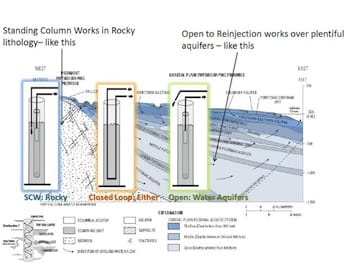 This Figure illustrates the lithology of the earth near Interstate I-95 in Virginia and reveals several opportunities and several restrictions. Although an open-loop GHP system is the most efficient and least costly to install, there really is no way to guarantee that there would be enough water flow in this Piedmont lithology. This means that either a closed-loop or SCW system must be chosen for design. A SCW is both less costly to install and more efficient because of its use of more stable water temperature delivery to the GHPs. The SCW is best chosen for design as field observations during drilling of the first bore can point to conditions favorable to an open to reinjection or closed-loop system. In short, it is easier from move to a “center design” session to either extreme.
This Figure illustrates the lithology of the earth near Interstate I-95 in Virginia and reveals several opportunities and several restrictions. Although an open-loop GHP system is the most efficient and least costly to install, there really is no way to guarantee that there would be enough water flow in this Piedmont lithology. This means that either a closed-loop or SCW system must be chosen for design. A SCW is both less costly to install and more efficient because of its use of more stable water temperature delivery to the GHPs. The SCW is best chosen for design as field observations during drilling of the first bore can point to conditions favorable to an open to reinjection or closed-loop system. In short, it is easier from move to a “center design” session to either extreme.
In the coastal plain, water is plentiful. All three geothermal well types could work there, but in this case, an open-well system would be least costly and most efficient under most conditions. Note that in an SCW, a good base of rock with a modest amount of water in fractures provides the best installation scenario. Unconsolidated earth and the required casing of the well diminish the first cost effectiveness of an SCW. Here is a case short case study on an SCW near Washington, DC.
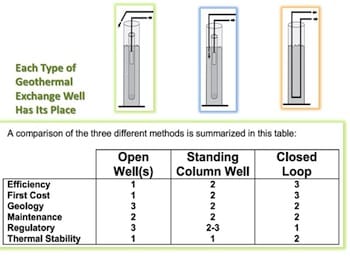 A comparison of the three different methods is presented in this table.
A comparison of the three different methods is presented in this table.
Efficiency
As stated earlier, an open well with a constant temperature of 50°F (15°C) in northern tiers of the United States provides the highest efficiency and lowest first cost but is highly dependent on the geology of the site not only to provide a high volume of water but also to provide an adequate receptor for the large volumes of recycled water. Also, an SCW with a winter temperature of 42 to 45°F (6–7°C) and a summer temperature of 65°C (18°C) has a slightly lower efficiency. Closed-loop systems have the lowest comparative efficiencies. Still, all GHP systems are more cost efficient heating and cooling than fossil fuel-based systems.
First Cost
Typically, open wells are found in unconsolidated earth with highly permeable formations. These formations are generally near the surface, and the drilling of a short bore minimizes cost. A companion reinjection or diffusion well, if employed, is also comparatively inexpensive. SCWs are deeper and are employed only in rock formations. Contrary to intuition, a drilled well in unconsolidated earth is about twice as costly as a rock well. An unconsolidated-earth well requires a casing to maintain the integrity of the borehole; a rock bore hole does not require casing. Closed-loop systems in unconsolidated earth generally require two to three times deeper bore depths per British thermal unit (Btu) of heat transfer. The added cost of the high density polyethylene (HDPE) plastic pipe, more and shorter bores, liquid and air purging, and antifreeze solutions add to these closed loop costs. Shorter bores are required to allow ease of insertion of the HDPE pipe and avoid high pressure drops in the closed-loop piping. Perhaps the best use for closed-loop or no-bleed SCW geothermal piping is in smaller single-family homes with similar cooling and heating loads, which can take advantage of the thermal storage characteristics of the earth, and recognize a desired 250 foot minimum SCW bore depth.
Geology
 An open well depends completely on the geology of the area, and without highly permeable soil or fractured rock, there is not enough water movement to provide reliable open-diffusion GHP operation. An SCW depends only on the existence of competent rock. Competent rock can be found near the surface in 60 to 65 percent of the continental United States. A closed-loop system is highly dependent on the amount of moisture in the soil and soil configuration and composition. Designed borehole length and resulting recirculation length can vary by a factor of 2 to 3 for the same heat-transfer capacity depending on the soil/earth configuration. In order to keep all large closed-loop designs within cost boundaries, larger projects often drill test bores. These test bores, further described in chapter 5, are then thermally evaluated to determine design factors before final designs are completed for the well field. Test bores for a SCW are designed and anticipated as the first SCW and test/first wells are not abandoned. The drilling of a test bore for a SCW may be used/anticipated as the first standing-column well to be drilled, and thus the cost associated with the test bore are not wasted.
An open well depends completely on the geology of the area, and without highly permeable soil or fractured rock, there is not enough water movement to provide reliable open-diffusion GHP operation. An SCW depends only on the existence of competent rock. Competent rock can be found near the surface in 60 to 65 percent of the continental United States. A closed-loop system is highly dependent on the amount of moisture in the soil and soil configuration and composition. Designed borehole length and resulting recirculation length can vary by a factor of 2 to 3 for the same heat-transfer capacity depending on the soil/earth configuration. In order to keep all large closed-loop designs within cost boundaries, larger projects often drill test bores. These test bores, further described in chapter 5, are then thermally evaluated to determine design factors before final designs are completed for the well field. Test bores for a SCW are designed and anticipated as the first SCW and test/first wells are not abandoned. The drilling of a test bore for a SCW may be used/anticipated as the first standing-column well to be drilled, and thus the cost associated with the test bore are not wasted.
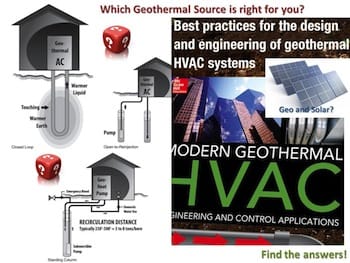 Even under ideal geologic conditions, closed-loop systems require more land surface area than an SCW or an open earth-coupling system.
Even under ideal geologic conditions, closed-loop systems require more land surface area than an SCW or an open earth-coupling system.
Maintenance
All three options should have periodic well/bore maintenance. Open and diffusion SCW systems must have flows and pump performance verified and be kept free of iron bacteria and other unwanted substances by annual assessment and remediation. Closed-loop systems should be checked periodically for pumping flow, fungi, iron bacteria, and acidification (loop pH) of the antifreeze solution.
Regulatory Issues
All three options must comply with varying federal, state, and local regulations. Open diffusing-well technology has been around longer and consequently is the most regulated typically. Although it is the most regulated of the three, the regulations are normally well established, and thermal exchange wells are defined as “a system composed of basic conventional water well and an injection well waters withdrawn, used for thermal exchange, and then returned to the same permeable zone from which they were removed.”
As an example, a 2600 gal/min thermal exchange well permit was pulled by a developer in Florida on the Pinellas County Emergency Operations Center for its geothermal chiller. The total cost of the permit was $25 because the design involved a well-established technology. It is not uncommon for well drillers and even the water authorities themselves to be unaware of these statutes.
Thermal Stability
Both SCWs and open diffusion wells have the additional advantage of advective heat transfer. Advective heat transfer actually moves the stable earth temperature/energy from a distance away as groundwater is forced to move to the well bore by water withdrawal. The advective heat transfer can compensate for January or August weather conditions in excess of projected federal or state guidelines. Buildings that do not fully meet insulation or infiltration design specifications benefit from the periodic and automatic advective heat transfer to compensate. Because closed-loop heat transfer depends solely on conductive heat transfer, there is little that can be done to compensate for design shortfalls. Compensation by added heating or cooling loads will dictate the addition of closed loops or supplement heating or cooling devices. Fossil fuel-based or electric supplemental energy source or sink devices are typically less efficient than a GHP
Most of the information in this article has been compiled from excerpts and illustrations from the textbook, Modern Geothermal HVAC Engineering and Controls Applications, McGraw-Hill Education
For geothermal HVAC training and listing in your area, visit geothermal industry organization sites: http://www.igshpa.okstate.edu/directory/directory.asp and http://www.geoexchange.org/geoexchange-service-providers
Jay Egg is a geothermal consultant, writer, and the owner of EggGeothermal. He has co-authored two textbooks on geothermal HVAC systems published by McGraw-Hill Professional. He can be reached at jayegg.geo@gmail.com.

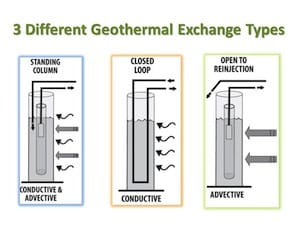
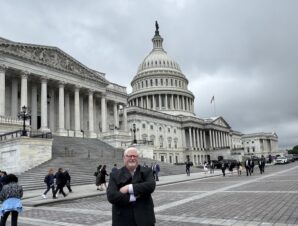


Join the conversation: